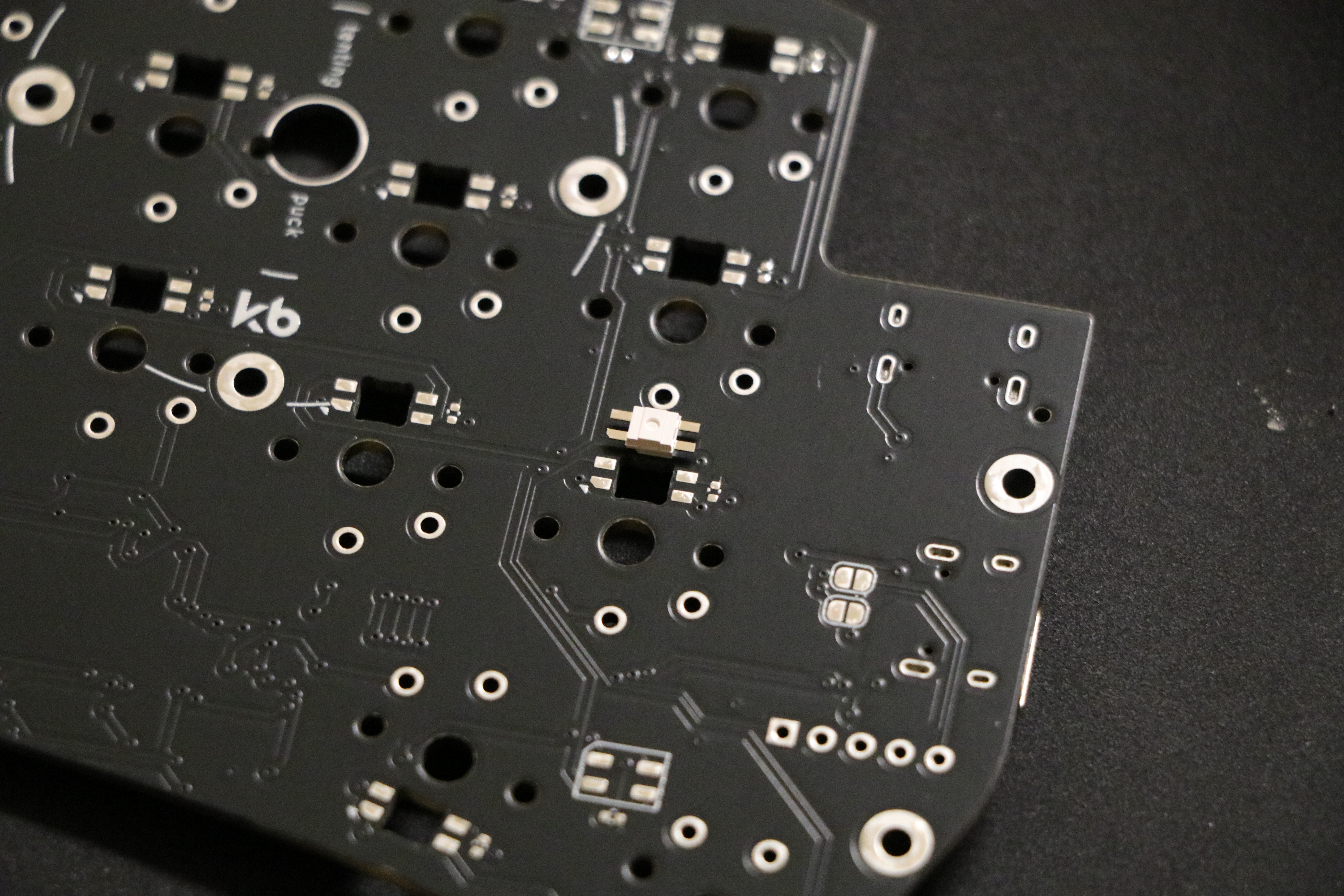A Ferris Sweep variant designed with an integrated RP2040 and some other added features.
This PCB has the exact same dimensions and mounting points (via SplitKB Tenting Puck mount) as original Sweep PCB, making it compatible with most existing cases. Due to the use of USB-C interconnects opposed to TRRS jacks, this PCB is not compatible with "high-profile" cases or cases that have a cutout for TRRS jacks. This PCB only supports soldered Choc V1 switches, as it is common to build this keyboard without a plate. Some other modifications include per-key RGB lighting and underglow, support for I2C OLED display or (some) SPI displays, and Cirque Trackpads via an FPC connector/cable. If you have any suggestions, please open an issue/pull request, or email.
The following instructions will be for JLCPCB, but should generally apply to most PCB manufacturers. If you would like a plate, the one here can probably be used, although I have not verified this.
- Upload the Gerber files from production/gerbers.zip
- Set the following parameters: (and change other things like PCB quantity and colour as desired)
- Different Design: 2
- For PCB assembly, choose Economic PCBA type and Top Side for assembly side. If you would like the LEDs and related components to be installed by PCBA, choose Standard and Both Sides.
- Upload BOM file from production/bom.csv on the Bill of Materials page
- Upload CPL file from production/positions.csv as well. Disregard any message like "J7, J8 won't be assembled due to missing data". These are the display pin headers.
- Choose "File Provided as Complete File, proceed with my own files"
- Select appropriate components on the following screen by typing in the shown part number and select it. An effort has been made to choose as few extended components as possible, but this is not possible for some. Note, footprints D1 & D2 are power indication LEDs. They can be left unpopulated if you'd rather not have an LED that is always lit. If you would like them installed while not being blinded, try to find an LED with a lower forward current and voltage (supply is 5v), perhaps something in the realm of 2v and 1-5mA. Note number 2, the current-smoothing capacitors for the RGB LEDs are not required for the LEDs to function.
- Give a quick look at the component placement and make sure nothing looks wildly wrong. It is normal for some components to be shown oriented incorrectly or not quite where they belong. The PCB reviewers will usually correct this without issue.
For components that are not carried or commonly out of stock at JLCPCB:
| Item | Quantity | Remarks |
|---|---|---|
| Cirque Trackpad (TM035035) | 1 or 2 | Also available in 23mm & 40mm diameter |
| FPC Connector (FH33J-12S-0.5SH) | 1 per trackpad | Not terribly difficult to do by hand-soldering |
| FPC Cable (98266-0118) | 1 per trackpad | Change length as desired |
| Nice!View Display (LS011B7DH03) | 1 or 2 | Available at a lower price if comfortable hand-wiring here |
| Acrylic Cover (cover.dxf) | 1 or 2 | Each uses 4x ~4mm M2 screws and 2x ~4mm M2 standofffs. Unfortunately due to the limited space, the cover can only be used without a display or trackpad |
These steps assume you already have an assembled PCB and are installing switches, RGB LEDs, displays, and/or other peripherals. If you are hand-assebling the PCBs with all components, the interactive BOM will be helpful.
- Ensure keyboard is functional by flashing firmware if necessary and testing by shorting switch footprint pins with metal tweezers. This should output keypresses on the computer.
- Install RGB LEDs if desired. The chopped-off corner should align with
the marked corner on PCB - this applies to both per-key and underglow
LEDs. Please double check orientation, as an incorrectly oriented LED
will result in keyboard not working. It is wise to test the LEDs as you
install them (eg. install a couple, then plug in keyboard). The per-key
LEDs will need to be installed and working before the underglow LEDs
will work.

- Install display(s) if desired. If using I2C OLED displays, install 1x4 header in left-most four pins and configure fimware appropriately.
- If adding a Cirque Trackpad, SPI will be used by default. This means that footprint R1 on the trackpad needs to be populated with a 4.7k resistor (refer to datasheet for additional info). If you would rather use I2C, the two jumpers on the back of each PCB need to be bridged and the R1 resistor on trackpad unpopulated. Configure firmware appropriately. Connect FPC cable to connector on PCB, and to connector on trackpad.
Only support for QMK Firmware has been written at this time, it can
be found here.
Enter bootloader mode by holding BOOT button and tapping RESET button.
The PCB supports full-duplex serial communication, VBUS detection for
setting handedness, and RGB data level-shifted to 5v. If you choose to
operate Cirque Trackpad by I2C, adjust rules.mk file so that
POINTING_DEVICE_DRIVERS is set to cirque_pinnacle_i2c and that I2C
is enabled in halconf.h file. Similarly, if you are using I2C OLED
displays, ensure features.quantum_painter is set to false, and
features.oled is set to true in keyboard.json file. Current
firmware has been written for LS011B7DH03 display, also known as
Nice!View display. It is rather
experimental at this time, as this display is not officially supported
by QMK.

